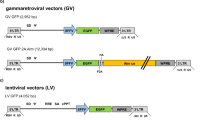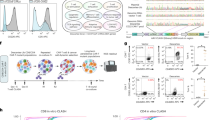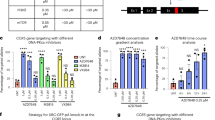Abstract
Ataxia–telangiectasia (A-T) is an autosomal recessive disorder characterized by neurodegeneration, immunodeficiency, cancer predisposition, genome instability, and radiation sensitivity. Previous research has shown that it is possible to correct the hereditary deficiency A-T by DNA transfection in cell culture, but the large size of the ATM cDNA (9 kb) limits the use of many vector types for gene replacement. HSV-1 amplicon vectors provide a means to deliver large genes to cells efficiently and without toxicity. In this study, the FLAG-tagged cDNA for human ATM was inserted into an HSV-1 amplicon under control of the CMV promoter (designated as HGC-ATM). FLAG-ATM expression was confirmed in 293T/17 cells and human A-T fibroblasts (GM9607) after transduction, by immunoprecipitation, Western analysis, and immunocytochemistry. Functional recovery was assessed by two independent assays. First, in vitro kinase assay showed that vector-derived ATM in GM9607 cells could successfully phosphorylate wt p53 using recombinant GST-p531–101. Second, in A-T cells infected with the HGC-ATM vector, the extent of accumulation in G2/M phase at 24 h postirradiation was similar to that observed in cells with wild-type endogenous ATM and lower than that observed in A-T cells infected with a control vector. Thus, these vectors provide a tool to test the feasibility of HSV-amplicons as gene therapy vectors for A-T.
This is a preview of subscription content, access via your institution
Access options
Subscribe to this journal
Receive 12 print issues and online access
$259.00 per year
only $21.58 per issue
Buy this article
- Purchase on Springer Link
- Instant access to full article PDF
Prices may be subject to local taxes which are calculated during checkout





Similar content being viewed by others
References
Lavin MF, Shiloh Y . The genetic defect in ataxia–telangiectasia. Annu Rev Immunol 1997; 15: 177–202.
Meyn MS . Ataxia–telangiectasia, cancer and pathobiology of the ATM gene. Clin Genet 1999; 55: 289–304.
Easton DF . Cancer risks in A-T heterozygotes. Int J Radiat Biol 1994; 66: S177–S182.
Khanna KK, Lavin MF, Jackson SP, Mulhern TD . ATM, a central controller of cellular responses to DNA damage. Cell Death Differ 2001; 8: 1052–1065.
Kastan MB, Lim D . The many substrates and functions of ATM. Mol Cell Biol 2000; 1: 179–185.
Savitsky K et al. A single ataxia telangiectasia gene with a product similar to PI-3 kinase. Science 1995; 268: 1749–1753.
Rotman G, Shiloh Y . ATM: from gene to function. Hum Mol Genet 1998; 7: 1555–1563.
Rotman G, Shiloh Y . ATM, a mediator of multiple responses to genotoxic stress. Oncogene 1999; 18: 6135–6144.
Beamish H, Williams R, Chen P, Lavin M . Defect in multiple cell cycle checkpoints in ataxia–telangiectasia postirradiation. J Biol Chem 1996; 271: 20486–20493.
Xu B, Kim ST, Lim DS, Kastan MB . Two distinct G2/M checkpoints are induced by ionizing irradiation. Mol Cell Biol 2002; 22: 1049–1059.
Canman CE et al. Activation of the ATM kinase by ionizing radiation and phosphorylation of p53. Science 1998; 281: 1677–1679.
Siliciano JD et al. DNA damage induces phosphorylation of the amino terminus of p53. Genes Dev 1997; 11: 3471–3481.
Jack MT et al. Chk2 is dispensable for p53-mediated G1 arrest but is required for a latent p53-mediated apoptotic response. Proc Natl Acad Sci USA 2002; 99: 9825–9829.
Lim DS et al. ATM phosphorylates p95/nbs1 in an S-phase checkpoint pathway. Nature 2000; 404: 613–617.
Xu B, O'Donnell AH, Kim ST, Kastan MB . Phosphorylation of serine 1387 in Brca1 is specifically required for the Atm-mediated S-phase checkpoint after ionizing irradiation. Cancer Res 2002; 62: 4588–4591.
Kim ST, Xu B, Kastan MB . Involvement of the cohesin protein, Smc1, in Atm-dependent and independent responses to DNA damage. Genes Dev 2002; 16: 560–570.
Taniguchi T et al. Convergence of the fanconi anemia and ataxia telangiectasia signaling pathways. Cell 2002; 109: 459–472.
Xu B, Kim ST, Kastan MB . Involvement of Brca1 in S-phase and G(2)-phase checkpoints after ionizing irradiation. Mol Cell Biol 2001; 21: 3445–3450.
Bao S et al. ATR/ATM-mediated phosphorylation of human Rad17 is required for genotoxic stress responses. Nature 2001; 411: 969–974.
Ziv Y et al. Recombinant ATM protein complements the cellular A-T phenotype. Oncogene 1997; 15: 159–167.
Zhang N et al. Isolation of full-length ATM cDNA and correction of the ataxia–telangiectasia cellular phenotype. Proc Natl Acad Sci USA 1997; 94: 8021–8026.
Uhrhammer N, Fritz E, Boyden L, Meyn MS . Human fibroblasts transfected with an ATM antisense vector respond abnormally to ionizing radiation. Int J Mol Med 1999; 4: 43–47.
Spaete R, Frenkel N . The herpes virus amplicon: a new eucaryotic defective-virus cloning-amplifying vector. Cell 1982; 30: 295–304.
Geller AI, Breakefield XO . A defective HSV-1 vector expresses Escherichia coli beta-galactosidase in cultured peripheral neurons. Science 1988; 241: 1667–1669.
Fraefel C et al. Helper virus-free transfer of herpes simplex virus type 1 plasmid vectors into neural cells. J Virol 1996; 70: 7190–7197.
Costantini LC et al. Gene transfer to the nigrostriatal system by hybrid herpes simplex virus/adeno-associated virus amplicon vectors. Hum Gene Ther 1999; 10: 2481–2494.
Wade-Martins R et al. An infectious transfer and expression system for genomic DNA loci in human and mouse cells. Nat Biotechnol 2001; 19: 1067–1070.
Saeki Y et al. Improved helper virus-free packaging system for HSV amplicon vectors using an ICP27-deleted, oversized HSV-1 DNA in a bacterial artificial chromosome. Mol Ther 2001; 3: 591–601.
Brown KD et al. The ataxia–telangiectasia gene product, a constitutively expressed nuclear protein that is not up-regulated following genome damage. Proc Natl Acad Sci USA 1997; 94: 1840–1845.
Watters D et al. Cellular localisation of the ataxia–telangiectasia (ATM) gene product and discrimination between mutated and normal forms. Oncogene 1997; 14: 1911–1921.
Gilad S et al. Ataxia–telangiectasia: founder effect among north African Jews. Hum Mol Genet 1996; 12: 2033–2037.
Lakin ND et al. Analysis of the ATM protein in wild-type and ataxia telangiectasia cells. Oncogene 1996; 13: 2707–2716.
Zhang N et al. An anti-sense construct of full-length ATM cDNA imposes a radiosensitive phenotype on normal cells. Oncogene 1998; 17: 811–818.
Jorgensen TJ, Russell PS, McRae DA . Radioresistant DNA synthesis in SV40-immortalized ataxia telangiectasia fibroblasts. Radiat Res 1995; 143: 219–223.
Sena-Esteves M, Saeki Y, Fraefel C, Breakefield XO . HSV-1 amplicon vectors – simplicity and versatility. Mol Ther 2000; 2: 9–15.
Hobbs II WE, DeLuca NA . Perturbation of cell cycle progression and cellular gene expression as a function of herpes simplex virus ICP0. J Virol 1999; 73: 8245–8255.
Roizman B, Knipe DM . Herpes simplex viruses and their replication. In: Knipe DM, Howley PM (eds). Fields Virology. Lippincott Williams-Wilkins: Philadelphia, 2001, pp 2399–2459.
Krummenacher C et al. Herpes simplex virus glycoprotein D can bind to poliovirus receptor-related protein 1 or herpesvirus entry mediator, two structurally unrelated mediators of virus entry. J Virol 1998; 72: 7064–7074.
Miller CG et al. Development of a syngenic murine B16 cell line-derived melanoma susceptible to destruction by neuroattenuated HSV-1. Mol Ther 2001; 3:160–168.
Maguir-Zeis KA, Bowers WJ, Federoff HJ . HSV vector-mediated gene delivery to the central nervous system. Curr Opin Mol Ther 2001; 3: 482–490.
Mulligan RC . The basic science of gene therapy. Science 1993; 260: 926–932.
Naldini L et al. In vivo gene delivery and stable transduction of nondividing cells by a lentiviral vector. Science 1996; 272: 263–267.
Kochanek S et al. A new adenoviral vector: replacement of all viral coding sequences with 28 kb of DNA independently expressing both full-length dystrophin and B-galactosidase. Proc Natl Acad Sci 1996; 93: 5731–5736.
Berns KI, Linden RM . The cryptic life style of adeno-associated virus. Bioessays 1995; 17: 237–245.
Wang Y et al. Herpes simplex virus type 1/adeno-associated virus rep(+) hybrid amplicon vector improves the stability of transgene expression in human cells by site-specific integration. J Virol 2002; 76: 7150–7162.
Heister T, Heid I, Ackermann M, Fraefel C . Herpes simplex virus type 1/adeno-associated virus hybrid vectors mediate site-specific integration at the adeno-associated virus preintegration site, AAVS1, on human chromosome 19. J Virol 2002; 76: 7163–7173.
Kotin RM et al. Site-specific integration of adeno-associated virus. Proc Natl Acad Sci USA 1990; 87: 2211–2215.
Bakowska JC et al. Targeted transgene integration into transgenic mouse fibroblasts carrying the full length human AAVS1 locus mediated by HSV/AAV rep+ hybrid amplicon vector. Gene Therapy, in press.
Pear WS, Nolan GP, Scott ML, Baltimore D . Production of high-titer helper-free retroviruses by transient transfection. Proc Natl Acad Sci USA 1993; 90: 8392–8396.
Smith IL, Hardwicke MA, Sandri-Goldin RM . Evidence that the herpes simplex virus immediate early protein ICP27 acts post-transcriptionally during infection to regulate gene expression. Virology 1992; 186: 74–86.
Laemmli UK . Cleavage of structural proteins during the assembly of the head of bacteriophage T4. Nature 1970; 277: 680–685.
Acknowledgements
We thank Douglas Olson and Joanne Yetz-Aldape who performed the FACS analysis. We thank Dr Yossi Shiloh for helpful suggestions and Dr Yoshinaga Saeki for advice and reagents. This work was supported by the A-T Children's Project, by NIH Grants CA71387 and CA21765 (to MBK), and by the American Lebanese Syrian Associated Charities of the St Jude Children's Research Hospital.
Author information
Authors and Affiliations
Rights and permissions
About this article
Cite this article
Cortés, M., Bakkenist, C., Di Maria, M. et al. HSV-1 amplicon vector-mediated expression of ATM cDNA and correction of the ataxia–telangiectasia cellular phenotype. Gene Ther 10, 1321–1327 (2003). https://doi.org/10.1038/sj.gt.3301996
Received:
Accepted:
Published:
Issue Date:
DOI: https://doi.org/10.1038/sj.gt.3301996



